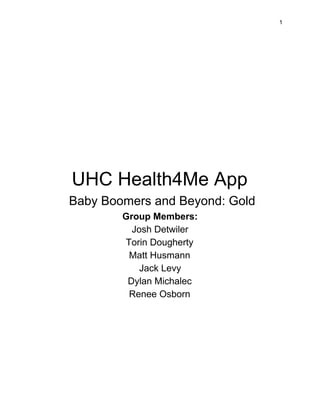
OBFinalProject
- 2. 2 Table of Contents Introduction/Preliminary Agreement 3 Review of Literature 5 Methodology 12 Data Summary 14 Recommendation Introduction 19 Recommendation 1 20 Recommendation 2 21 Recommendation 3 23 Conclusion 28 Appendix 30 Group Member Timesheet 57 IRB approval 58
- 32. 32 RECOMMENDATION 1 SOURCE Collins, B. (2013, March 1). Baby Boomer Marketing: Reaching the Most Valuable Generation. Vocus Blog. Retrieved May 12, 2014, from http://www.vocus.com/blog/marketingtobabyboomersonline/ SURVEY DATA 1. Are you male or female? Answer Options Response Percent Response Count Male 28.7% 35 Female 71.3% 87 2. Which category below includes your age? Answer Options Response Percent Response Count 4145 17.2% 21 4650 26.2% 32 5155 33.6% 41 5660 16.4% 20 Other 6.6% 8 3. What is your ethnicity? Answer Options Response Percent Response Count White 91.0% 111 Black or AfricanAmerican 3.3% 4 American Indian or Alaskan Native 0.0% 0
- 33. 33 Asian 4.1% 5 Native Hawaiian or other Pacific Islander 0.0% 0 Other 1.6% 2 4. Having a mobile health care application Answer Options Not important A little important Somewhat important Important Very important Rating Average 35 23 27 29 3 2.50 5. Confidentiality of your health care information Answer Options Not important A little important Somewhat important Important Very important Rating Average 3 8 9 24 73 4.33 6. Having a simple to use application Answer Options Not important A little important Somewhat important Important Very important Rating Average 6 7 12 41 51 4.06 7. Immediate contact with a health care representative Answer Options Not important A little important Somewhat important Important Very important Rating Average 6 7 16 46 42 3.95
- 34. 34 8. Rate the following from least (4) to most (1) important: Answer Options 1 2 3 4 Rating Average Having a mobile health care application 16 15 24 60 3.11 Confidentiality of your health care information 61 27 23 4 1.74 Having a simple to use application 9 36 47 23 2.73 Immediate contact with a health care representative 29 37 21 28 2.42 9. The ability to search for nearby physicians Answer Options Not important A little important Somewhat important Important Very important Rating Average 4 7 26 42 31 3.81 10. The ability to search for hospitals in the area Answer Options Not important A little important Somewhat important Important Very important Rating Average 4 6 22 52 26 3.82 11. The ability to estimate health care costs Answer Options Not important A little important Somewhat important Important Very important Rating Average 1 6 15 48 40 4.09
- 35. 35 12. The ability to contact a registered nurse 24 hours/ 7 days a week Answer Options Not important A little important Somewhat important Important Very important Rating Average 3 5 16 44 42 4.06 13. The ability to estimate health procedure/treatmen t costs Answer Options Not important A little important Somewhat important Important Very important Rating Average 2 4 16 51 35 4.05 14. Having an accessible personal health record Answer Options Not important A little important Somewhat important Important Very important Rating Average 1 2 14 47 44 4.21 15. Having access to information of family members on your account Answer Options Not important A little important Somewhat important Important Very important Rating Average 2 5 11 51 39 4.11
- 36. 36 16. The ability to check your health savings balance Answer Options Not important A little important Somewhat important Important Very important Rating Average 7 6 14 40 41 3.94 INTERVIEW DATA UHC Interview Questions: Name of Participant 1. Collect basic demographic information from interviewee: Name, age, gender, employment status, martial status, children(/providing care)… others? (We could use information gathered from these last two in visual aspects of our campaign.) 2. Do you have a smartphone? a. Do you utilize apps? If so, what sort of apps do you find yourself downloading most often? (Games, social media, news media, reference [provides info], productivity [helps you get things done], etc) b. What drew you to these specific apps? c. Do you continue to use them? Why or why not? 3. Describe how you view yourself. a. Describe how you view your stage in life, 4160 “older adult”. 4. How do you determine where you get health insurance/health care information from? (word of mouth, patient ratings, physicians, online, marketing campaigns, etc.) 5. Hand Health4Me app over to subject and let them experiment. Note what features they particularly like or dislike and ask them WHY they feel that way about a certain feature. (We can use this information to select those features we should emphasize within our marketing campaign.) Answers: 1. UHC Interview, Bill Beledere, Matt’s Mentor 1.William Belvedere 49. Male, working at Schecter Dokken Kanter full time. Exempt. Married 2 children. Senior in high school. Sophomore girl. 2. Yes. iPhone 4s a. Most often use email. Then calendar app. Texting. Maps. Find friends. Safari/google. Photos. Shazam. Sonos? (sounds system wireless way to tab into music). Fly Delta. Solitare. US Open for during masters. Sports Center. b. Anything business or life related is good. He likes music, which is why he has those. Fly delta is important because it’s useful. Organization is key. C. One that he had was Roost (it shows you a news flash, but he doesn’t like it). Too much information overload caused him to stop .